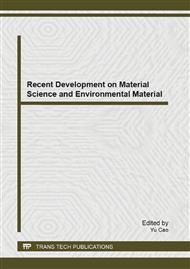[1]
Jeffrey G. Skousen, Alan Sexstone, Paul F. Ziemkiewicz, Acid mine drainage control and treatment, in: Barnhisel R etal. (eds), Reclamation of Drastically Disturbed Lands, American Soc of Agronomy Monogr 41, Madison , 2000, pp.131-168.
DOI: 10.2134/agronmonogr41.c6
Google Scholar
[2]
Sullivan P J, Yelton J L, An evaluation of trace element release associated with acid mine drainage, Environment Geology Water Science. 12(1988): 181- 186.
DOI: 10.1007/bf02574730
Google Scholar
[3]
Zhou G P, Fu D F, Application and development for micro-electrolysis technology, Techniques and Equipment for Environmental Pollution Control. 2(4)(2001): 18-24. (in Chinese).
Google Scholar
[4]
Zhang C Y, Research on Wastewater Treatment Techniques by Ferric-Carbon Micro-Electrolysis , Nanjing: Southeast University, 2004. (in Chinese).
Google Scholar
[5]
Hao R X, Chen S Y, Huang Q X, Pretreatment of less-biodegradable printing and dyeing waste water by iron chipping-filtration process, Environmental Protection of Chemical Industry. 19(3)( 1999): 135-139. (in Chinese).
Google Scholar
[6]
Jin Y Z, Zhang Y F, Li W, Micro-electrolysis technology for industrial wastewater treatment, J of Environmental Sciences. 15(3) (2003): 334-338.
Google Scholar
[7]
Li Z, Willian A A, Raymond M H, Kinetics of haloacetic acid reactions with Fe(0), Environ Sci Technol. 38(2004): 6881-6889.
Google Scholar
[8]
Marek S O, Lai G Robert W G, Reduction of N-nitrosodimethylamine with granlar iron and nickel-enhanced iron: Mechanisticstudies, Environ Sci Technol. 34(2000): 3495-3500.
DOI: 10.1021/es9909780
Google Scholar
[9]
Xiao Hong-kan, Xiao Shu-hu, Song Yong-hui, Zeng Ping, Shao Hong, Zhang Guo-fang, Li Hui, Study on the Pretreatment and Copper Recovery from Berberine Wastewater Containing Copper by Fe-C Micro-electrolysis, Journal of Environmental Engineering Technology. 1(1)( 2011): 15-19. (in Chinese).
Google Scholar
[10]
X.B. Gu, Z.M. Zheng, H.Q. Yu, J. Wang F.L. Liang R.L. Liu, Optimization of medium constituent for a novel lipopeptide production by Bacillus subtilis MO–O1 by a response surface method, Process. Biochem. 40 (2005): 3196–3201.
DOI: 10.1016/j.procbio.2005.02.011
Google Scholar
[11]
S.R. Senthilkumar, B. Ashokkumar, K. Chandra Raj,P. Gunasekaran, Optimization of medium composition for alkali-stable xylanase production by Aspergillus fischeri Fxn 1 in solid-state fermentation using central composite rotary design. Bioresour, Technol. 96(2005 ): 1380–1386.
DOI: 10.1016/j.biortech.2004.11.005
Google Scholar
[12]
F.J. Cui, Y. Li,Z.H. Xu,H.Y. Xu,K. Sun W.Y. Tao, Optimization of the medium composition for production of mycelial biomass and exopolymer by Grifola frondosa GF9801 using response surface methodology . Bioresour, Technol. 97(2006): 1209–1216.
DOI: 10.1016/j.biortech.2005.05.005
Google Scholar
[13]
S. Oh, S. Rheem,J. Sem,S. Kim,Y. Baek, Optimizing conditions for the growth of Lactobacillus casei YIT 9018 in tryptone- glucose medium by using response surface methodology, Appl. Environ. Microbiol. 61 (1995): 3809–3814.
DOI: 10.1128/aem.61.11.3809-3814.1995
Google Scholar
[14]
S. Puri, Q.K. Beg, R. Gupta, Optimization of alkaline protease production from Bacillus sp. by response surface methodology. Curr. Microbiol. 44(2001)286–290.
DOI: 10.1007/s00284-001-0006-8
Google Scholar
[15]
R.H. Myers, D.C. Montgomery, Response Surface Methodology Process and Product Optimization Using Designed Experiments. 2nd ed., John Wiley, New York, (2002).
Google Scholar
[16]
G. Box, N. Draper, Empirical Model Building and Response Surfaces, John Wiley& Sons, New York, (1987).
Google Scholar
[17]
P. Ricou, I. Lecuyer, P. Le Cloirec, Influence of pH on removal of heavy metallic cations by fly ash in aqueous solution, Water Res. 35 (2001): 965–976.
DOI: 10.1080/09593331908616758
Google Scholar
[18]
R.H. Myers, D.C. Montgomery. Response Surface Methodology Process and Product Optimization Using Designed Experiments, 2nd ed., John Wiley. NewYork, (2002).
Google Scholar
[19]
R.H. Myers, D.C. Montgomery, Response Surface Methodology: Process and Product Optimization using Designed Experiments, second ed., John Wiley & Sons, USA, (2002).
Google Scholar
[20]
A.M. Joglekar, A.T. May, Product excellence through design of experiments. Cereal Foods World. 32(1987): 857–868.
Google Scholar
[21]
Liu Yongyue, Jia Cuiyin, Improvement research of iron hydroxide sol electrophoresis experiment, Laboratory science. 5 (2008): 85-86. (in Chinese).
Google Scholar
[22]
Chen Shiguan, Analysis of replacement of electrochemical process and process, Shanghai nonferrous metal. 17(1) (1996): 36-41. (in Chinese).
Google Scholar
[23]
Zhou R J, Xu J P, Zhang Ming, Printing and dyeing wastewater flocculation treatment optimization by response surface methodology, Water supply and drainage. 37(11) (2011): 139-143. (in Chinese).
Google Scholar


